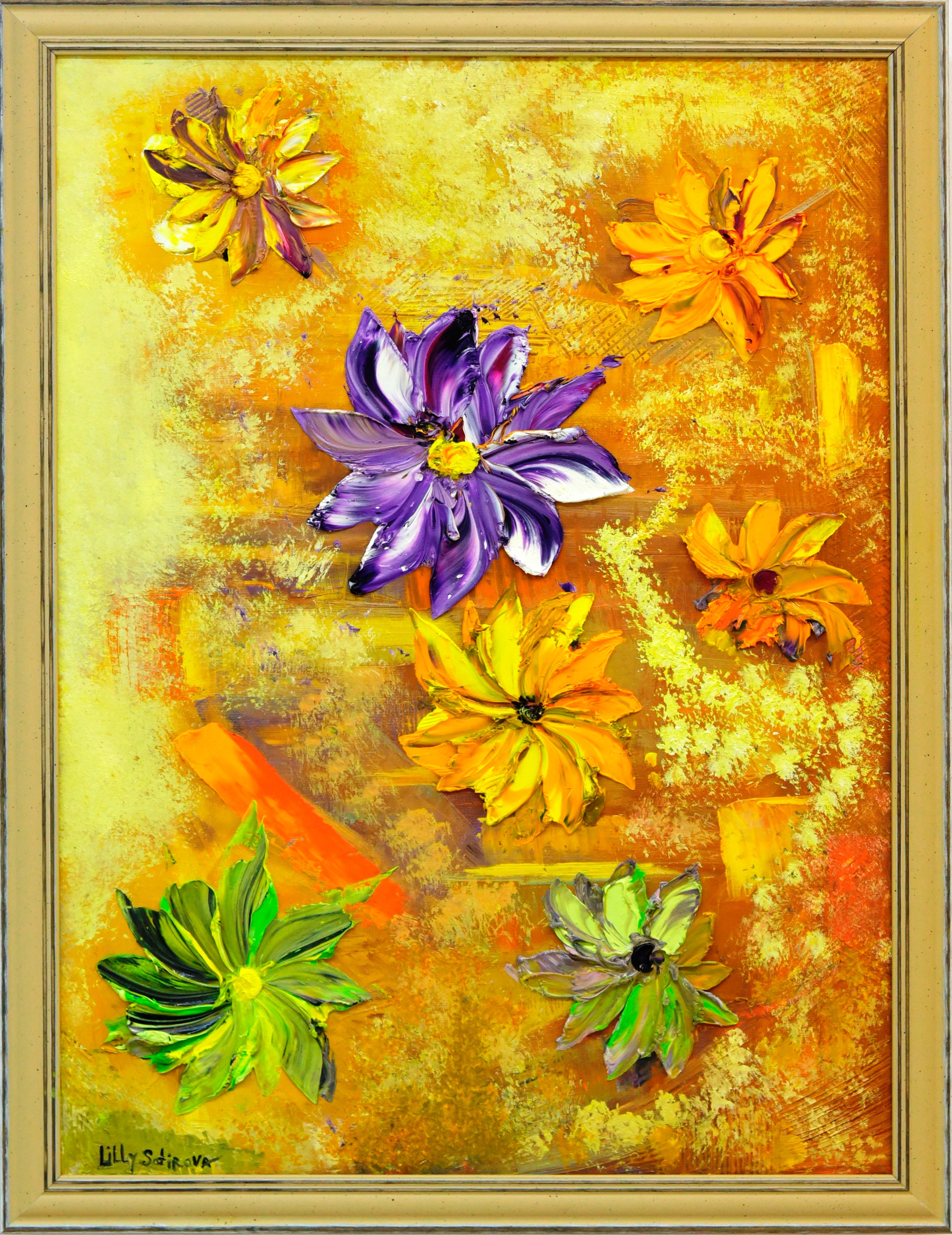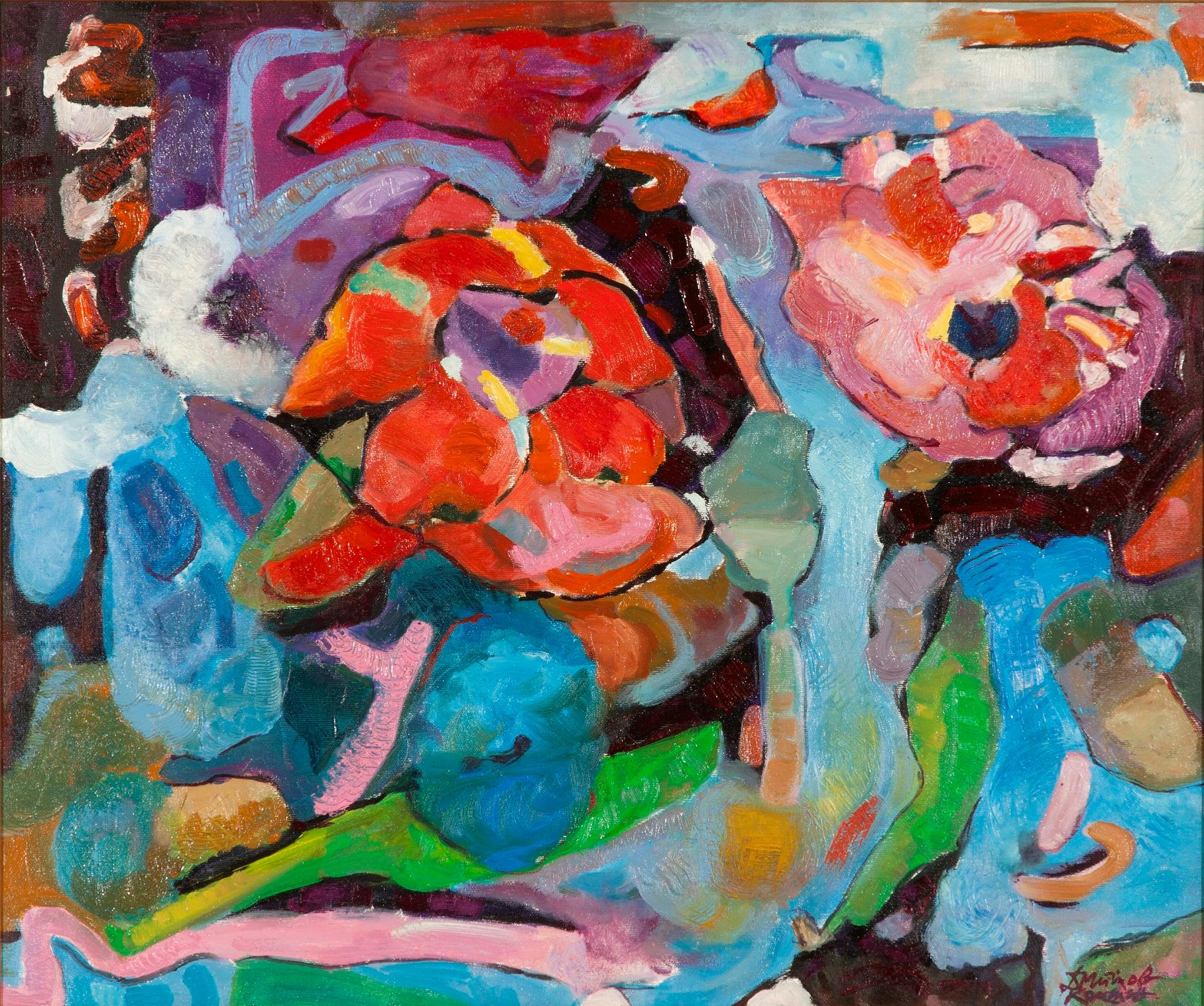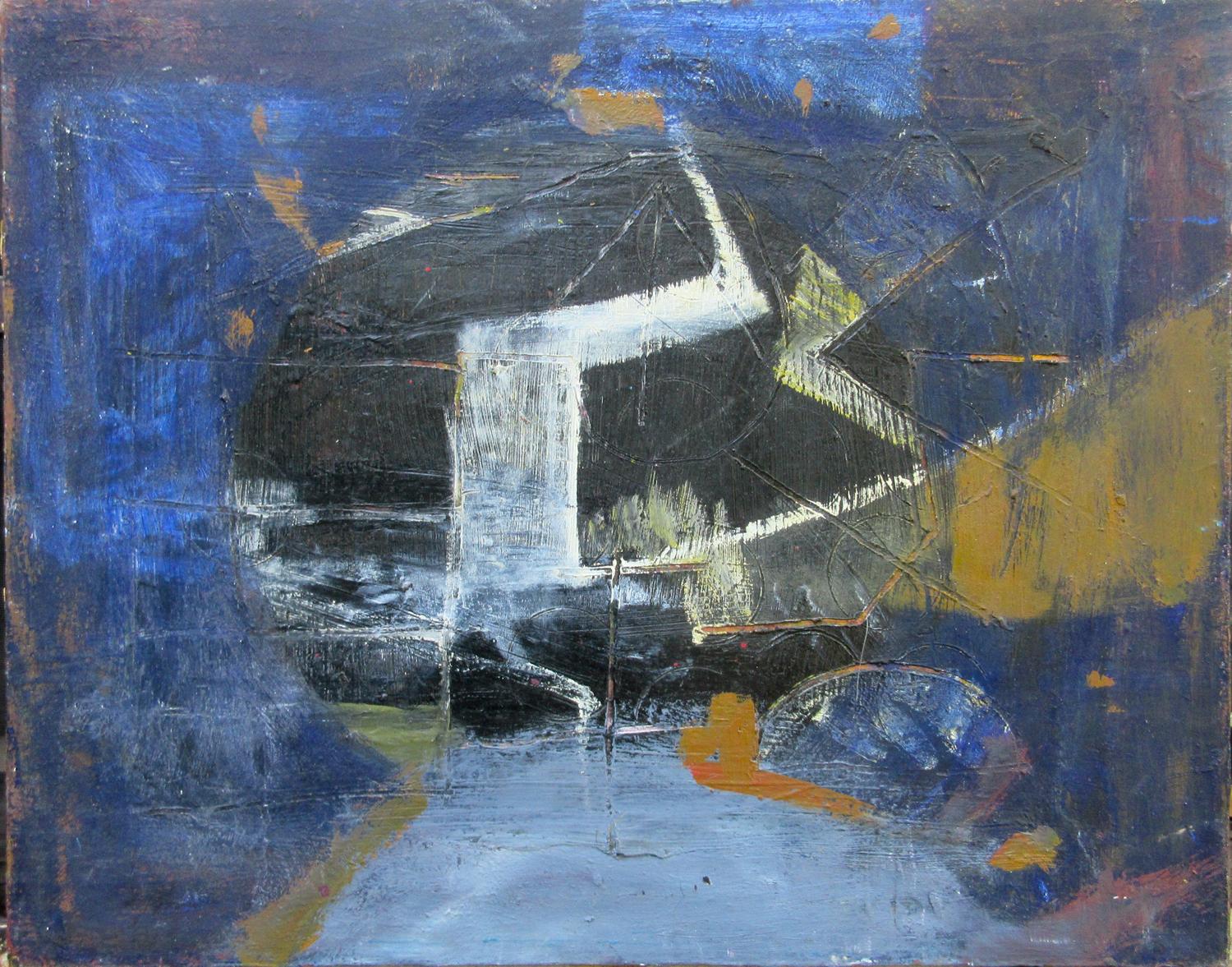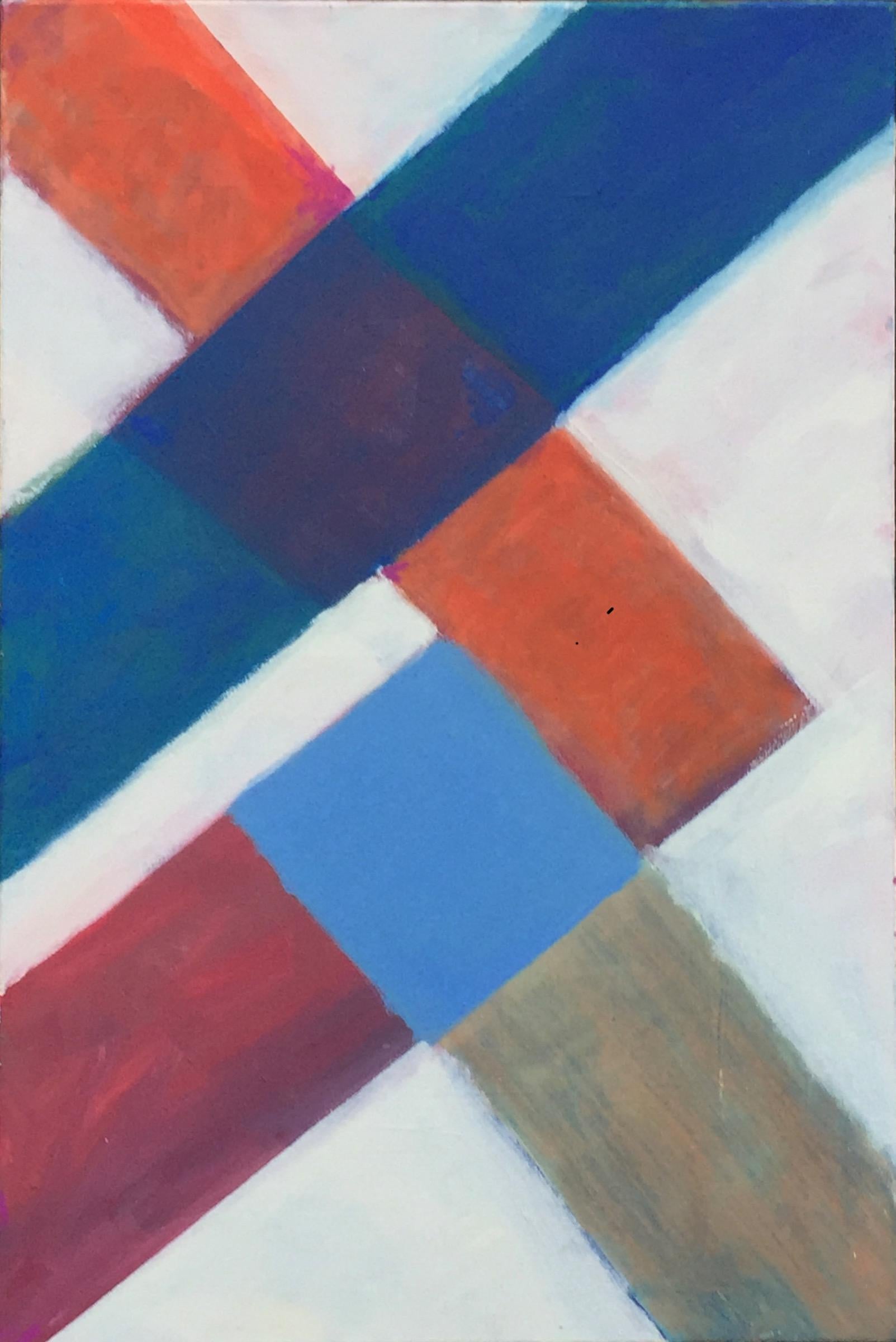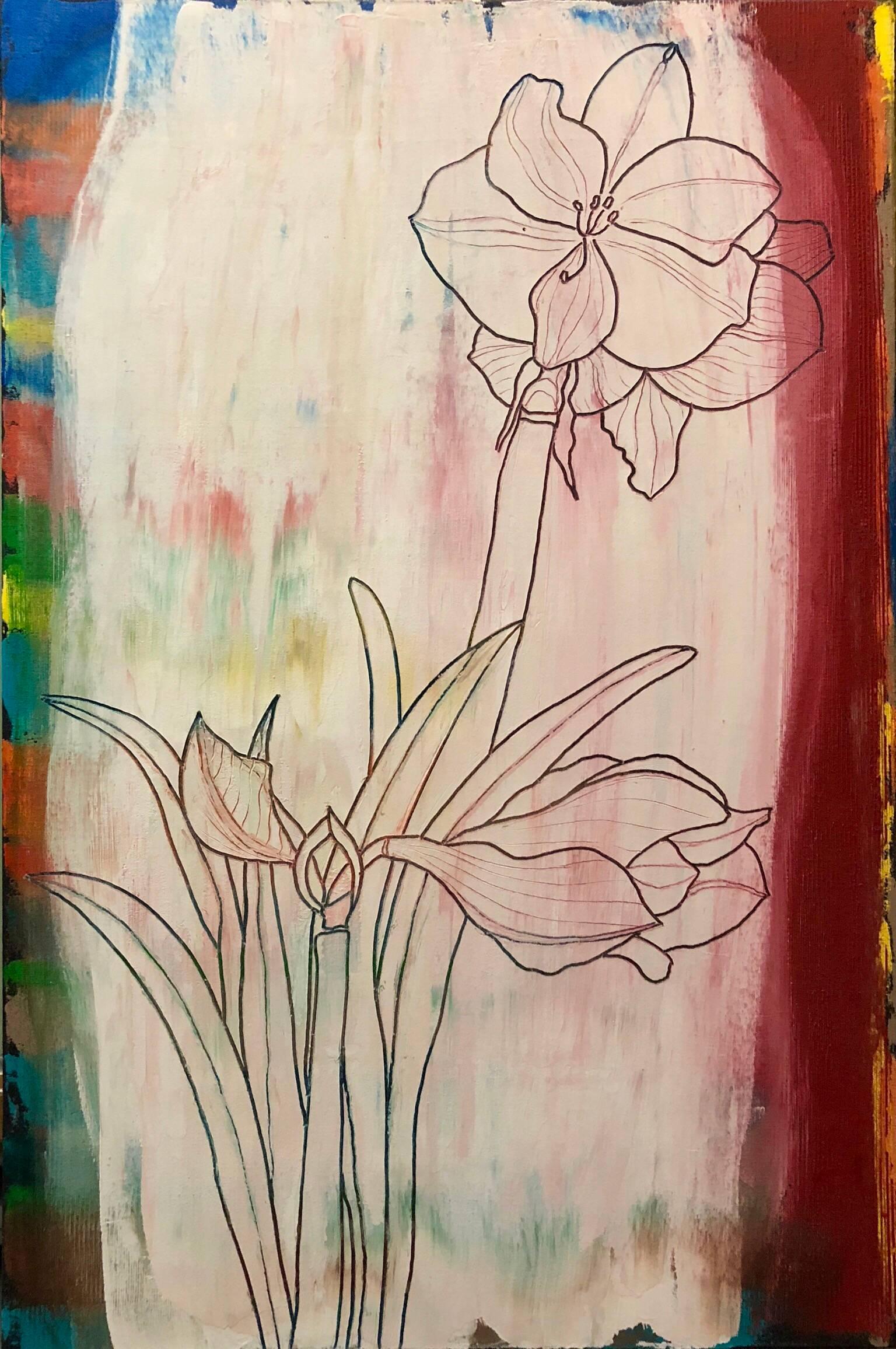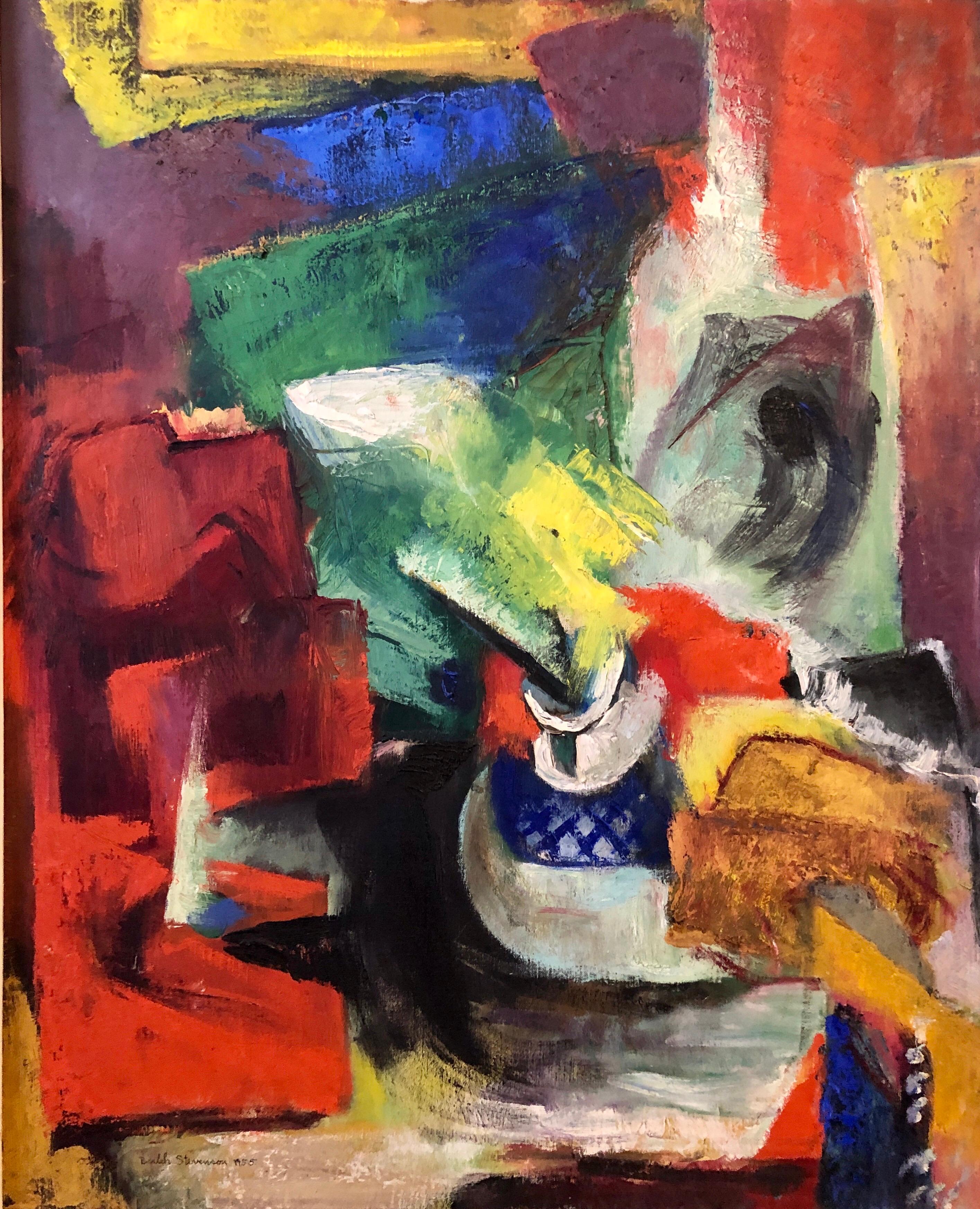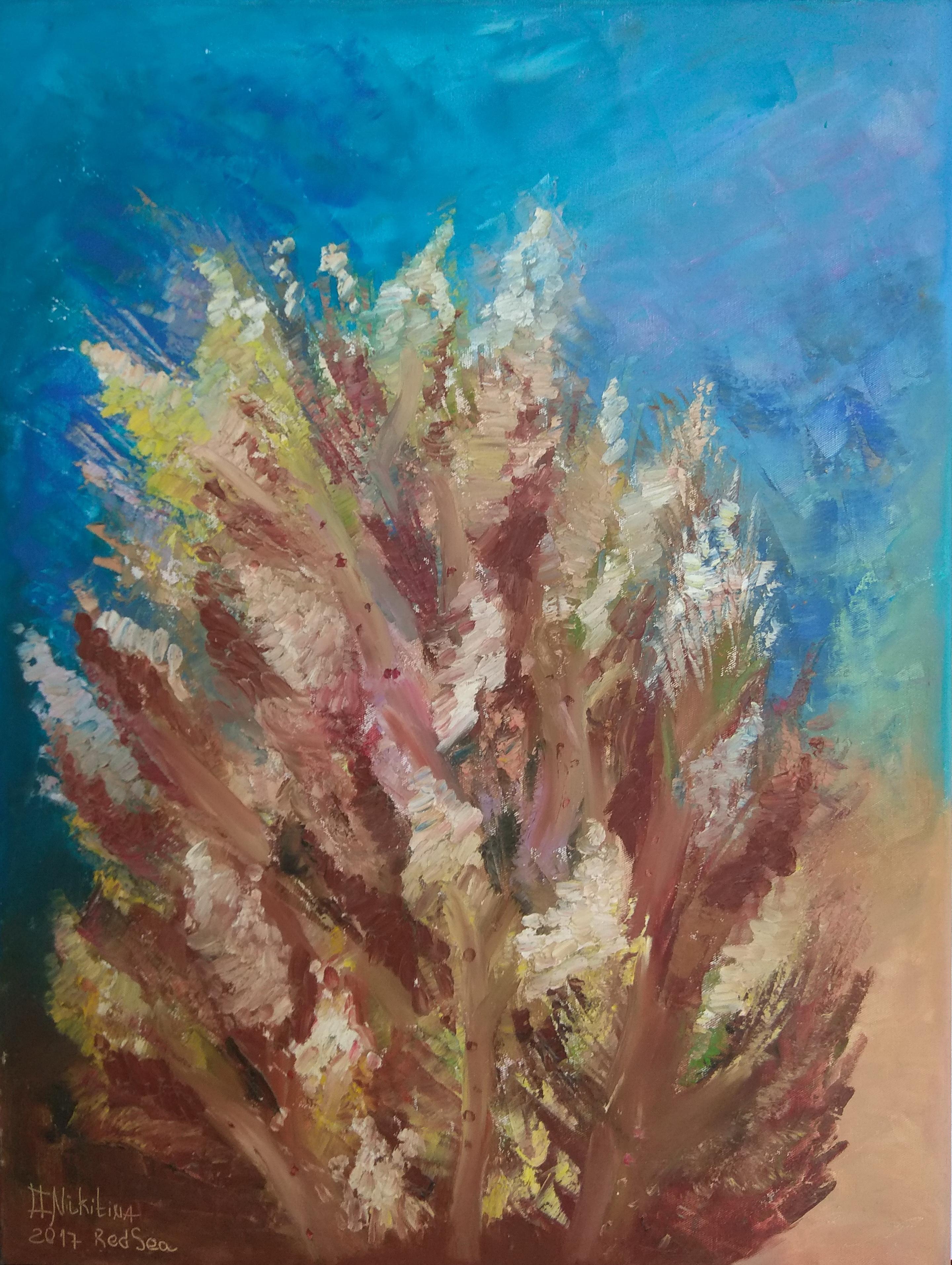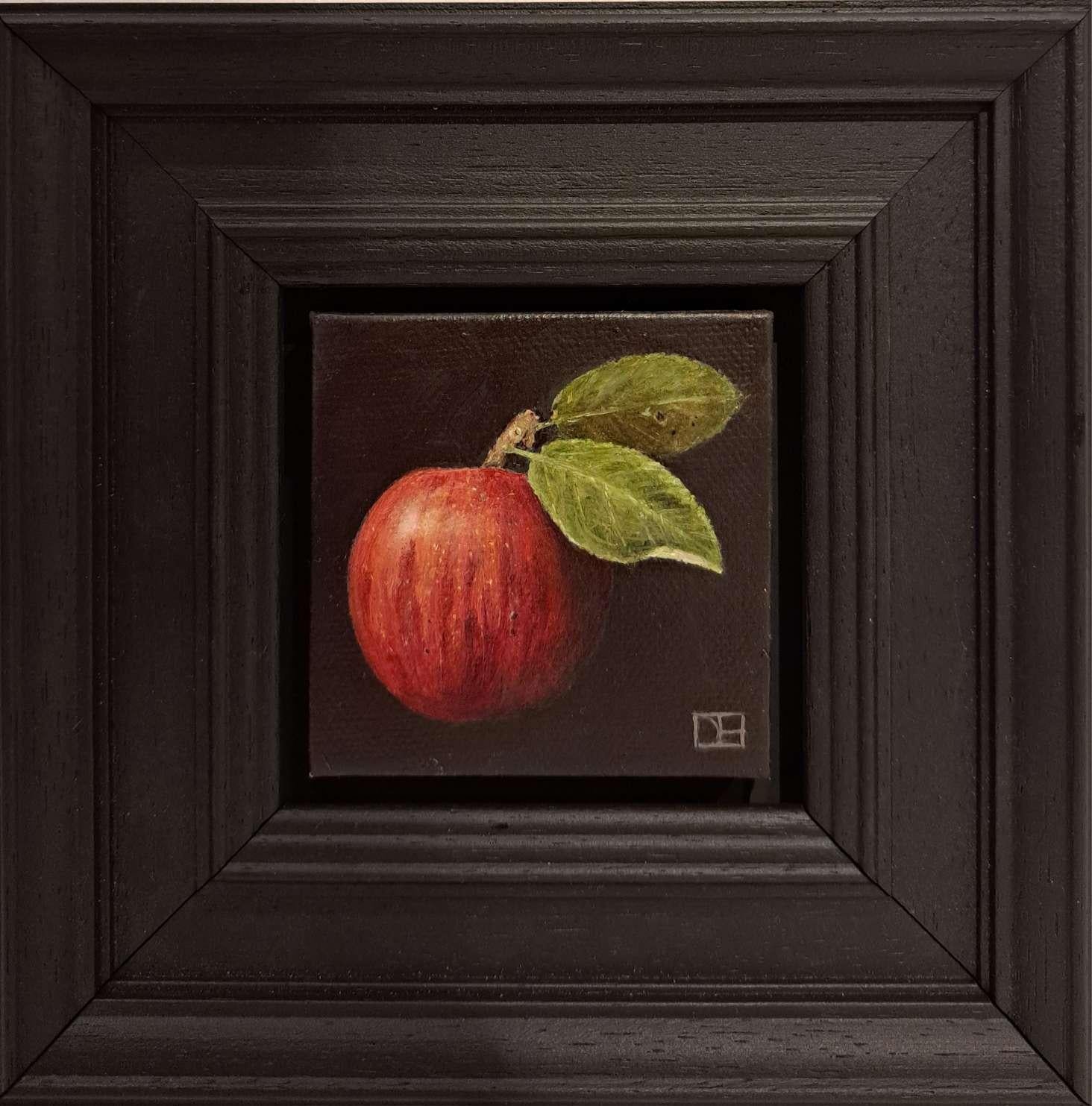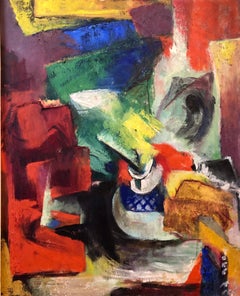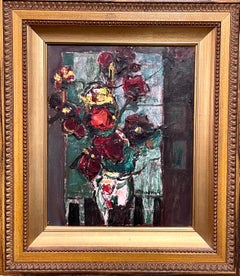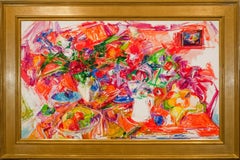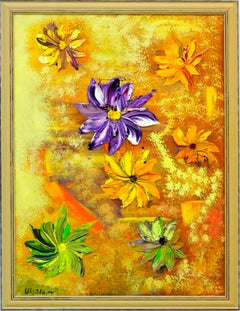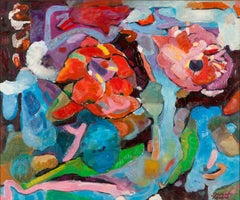
Large Modernist Indian Abstract Geometric Cubism Oil Painting Mohan Sharma 1971
View Similar Items
Want more images or videos?
Request additional images or videos from the seller
1 of 16
Mohan SharmaLarge Modernist Indian Abstract Geometric Cubism Oil Painting Mohan Sharma 1971 1971
1971
About the Item
- Creator:Mohan Sharma (1942 - 1988, Indian)
- Creation Year:1971
- Dimensions:Height: 21 in (53.34 cm)Width: 61 in (154.94 cm)
- More Editions & Sizes:uniquePrice: $10,000
- Medium:
- Movement & Style:
- Period:
- Condition:good. minor wear. please see photos.
- Gallery Location:Surfside, FL
- Reference Number:1stDibs: LU38212319032
About the Seller
4.9
Platinum Seller
These expertly vetted sellers are 1stDibs' most experienced sellers and are rated highest by our customers.
Established in 1995
1stDibs seller since 2014
1,558 sales on 1stDibs
Typical response time: 1 hour
More From This SellerView All
- Abstract Flowers Oil Painting Study for AmaryllisBy Nobu FukuiLocated in Surfside, FLThis piece is done in a sort of sgraffito technique with the flowers sort of etched in the paint. Born in Tokyo, Japan, Nobu Fukui Came to New York where he became a US citizen. From 1964 - 65, he studied at the Art Students League in New York City. His work has been widely exhibited in New York and California. He had his first one-man show in this country in 1965 at the Daniels Gallery in New York. That same year his works were included in the Japanese Artists in Europe and America Exhibition at the National Museum of Modern Art in Tokyo. This was followed by numerous exhibits and one-man shows in various cities in the United States and Japan - New York, Indianapolis, Ann Arbor, Pittsburgh and Yokohama, for example. Fukui's works are formal, dynamic and abstract. Form functions minimally as a symmetrical structure so as to focus on his real interest in color interaction. Fukui's work is represented in the collections of The Museum of Modern Art, New York City; Larry Aldrich Museum, Conn; Dartmouth College, NH; New York State University, Potsdam NY; Roosevelt College, Chicago IL; Westinghouse Corp, The National Museum of Modern Art, Tokyo, Japan; The New Britain Museum of American Art, New Britain, CT; The Indianapolis Museum of Art, Indianapolis, IN and The Eli and Edythe Broad Art Museum, East Lansing, MI, Indianapolis Museum of Art; National Museum of Modern Art, Tokyo and National Museum of Modern Art, Kyoto, Japan; amongst others. and other private collections. He has exhibited widely, including solo shows at Daniels Gallery, Max Hutchinson Gallery, Marisa Del Re Gallery, and Steven Haller...Category
1990s Abstract Abstract Paintings
MaterialsCanvas, Oil, Panel
- Beulah Stevenson 1950s Abstract Expressionism American Woman Artist Oil PaintingBy Beulah StevensonLocated in Surfside, FLDimensions: 32"h, 25"w canvas; 38.5"h, 32"with frame Work is titled "Two Lillies" Elsie Stevenson (1890–1965) was an American painter and printmaker. Beulah Stevenson, (1875-1965) American painter and printmaker. Born in Brooklyn Heights, Beulah (Elsie Sloan) Stevenson lived there her entire life. In New York she studied at the Pratt Institute and the Art Students League, where her instructors included Ashcan artist John Sloan; in Provincetown, she worked and studied with Abstract Expressionist artist Hans Hofmann (an influential teacher whose students included many notable artists including Lee Krasner, Helen Frankenthaler, Irene Rice Pereira, Gerome Kamrowski, Fritz Bultman, Wolf Kahn, Marisol Escobar and Beulah Stevenson), a long-time curator at the Brooklyn Museum, was also among his pupils. Her work appeared in many group shows, and she won a number of awards. She was a curator at the Brooklyn Museum for many years, and that museum owns a number of examples of her work, as do the Library of Congress and the New York Public Library. Stevenson maintained many professional associations during her career; she was president of the New York Society of Women Artists, a board member of the National Association of Women Artists, and a vice-president of the Brooklyn Society of Artists, Art Institute of Chicago, International Graphic Society Inc., Philadelphia Print Club, Provincetown Art Association and the Creative Artist's Association. She also belonged to the American Artists' Congress which promoted social-realist style of American scene painting, she left to join the Federation of Modern Painters and Sculptors established To Promote Avant-Garde Art. Stevenson was said by a friend to have destroyed many of her papers prior to her death, but a collection was donated to the Archives of American Art at the Smithsonian Institution. Select Group Exhibitions Art Institute of Chicago; , Library of Congress, Washington, D.C.; Print Club of Philadelphia; National Arts Club, New York; Metropolitan Museum; Whitney Museum; Brooklyn Museum; Chicago Art Institute; Pennsylvania Academy Of Fine Arts; Rochester Memorial Museum; St. Paul Museum; M. H. De Young Memorial Museum Of Art; Houston Museum Of Art; William R. Nelson Museum Of Art; Columbus Museum Of Art; American Institute Of Graphic Arts; Provincetown Art Association; Columbia Museum Of Art; Schenectady Museum Of Fine Art; Portland Museum, ME; Royal Society, London; Gallery O...Category
Mid-20th Century Abstract Expressionist Abstract Paintings
MaterialsCanvas, Oil
- Polish Israeli Abstract Flowers Tel Aviv Modernist Vibrant Floral Oil PaintingBy Zvi MairovichLocated in Surfside, FLBold, colorful abstract bouquet of flowers in a vase. 25.5 X 20 inches, framed. 16 X 12.5 canvas in original carved wood frame. Provenance: Gallery Hadassa (Klachkin) Tel Aviv. Bears label remnant verso. Zvi Mairovich (1911-1974) was one of the most important Israeli abstract painters. Born in Krosno Poland, he moved to Berlin in 1929, studying painting with Karl Hofer...Category
20th Century Abstract Abstract Paintings
MaterialsCanvas, Oil
- "AKEE" Oil Painting, Marylyn Dintenfass Modernist Abstract Expressionist Pop ArtBy Marylyn DintenfassLocated in Surfside, FLProvenance: Babcock Galleries (bears their label verso.) signed verso with artists monogram signature. Marylyn Dintenfass (born 1943) is an American painter, printmaker, and sculptor. She is primarily known for her oil paintings, which use a dynamic color palette and lexicon of gestural imagery to explore dualities in the human experience and everyday sensual pleasures. Marylyn Dintenfass was born in 1943 in Brooklyn, New York and spent most of her early years in Brooklyn and then Long Island. She attended Queens College, and graduated in 1965 with a bachelor's degree in Fine Arts. During this time, the artist worked with Abstract Expressionist painter John Ferren and muralist Barse Miller. Marilyn Dintenfass explored new media and developed her own reaction to abstract expressionism with color, line, and gesture. Dintenfass acquired an appreciation for a broad range of materials that led to major sculpture installations composed of ceramic materials, steel, lead, wood, wax and a variety of pigments and epoxies. Following a tour of museums in Amsterdam, Paris and Rome, the artist made her way to Jerusalem in 1966. During this journey, the artist worked with painter Ruth Bamberger, studied etching and mingled with the artists and intellectuals of the city. The result was Dintenfass's first architectural commission, to design the “Pop Op Disco,” Jerusalem's first disco. This commission allowed her to work with an array of materials to employ shapes, surfaces, textures, colors, and lights, all of which coalesced in her consciousness that would become important components of her mature personal visual vocabulary. Dintenfass also married and started her family during these years. Art critic Meredith Mendelsohn writes, “Dintenfass uses luscious colors, repetitive forms, and a gestural intensity that combines Abstract Expressionism and Pop Art.” Dintenfass often works with oil paint on wooden panels fragmented into parts of a grid. "After completing a painting," writes curator and critic Lilly Wei in a study of Dintenfass' work, "Dintenfass literally takes it apart, treating each panel as a discrete entity, exchanging panels between works in an aesthetic mix and match as she searches for interactions and relationships of color and form that satisfy her sense of visual excitement, sparked by the frisson of the dissonant." In an interview with critic Irving Sandler, Dintenfass speaks of the grid as a necessary, formal restraint for the passion of the gestural marks it contains. Joyce Robinson illuminates; “Dintenfass is at heart, though, a painter, and the grid, with its reference to and notion of modular parts, has remained central to her artistic enterprise, functioning as a kind of Apollonian matrix holding in check the exuberant, vividly colored abstractions of this essentially Dionysian artist.” Lilly Wei adds, "Ultimately, however, Dintenfass is more sensualist than theorist, and her paintings owe much of their allure to their materiality and the dazzle of color. Her array of ripe, radiant, saturated hues—a palette of gorgeous diversity—can be silkily smooth and nuanced; boldly exuberant; or edgily, feverishly discordant." The artist's abstract imagery usually appears in her work as various forms of stripes or circles arranged across translucent layers of alternating matte and high gloss textures. In a conversation with gallery owner, John Driscoll, Dintenfass likens these symbols to language that predates the written word, saying her "work relates to communication through the visceral channel." Rooted in autobiography, the artist's paintings also examine the contrast between what she calls the “micro” and the “macro.” At times the shapes simultaneously resemble cells under a microscope and visions of the cosmos. Dintenfass' themes explore the dualities of everyday pleasures; depending on the focus of a series, her symbols might conjure characters, candies, car wheels, or paint itself. Although known for her paintings, Dintenfass was first recognized for her sculptural installations. Her innovative use of mixed media (ceramics, epoxies, wax, pigments, steel, lead, wood, etc.) transformed understanding of what a “ceramic” work of art could be and firmly fixed her position and influence among a generation of mixed media artists expanding the traditional definitions and boundaries of object and materials to create modern art. The results came as architectural reliefs and installation sculpture unique to her organic but structural personal style. Similar to her paintings, Dintenfass developed a modular language of symbols, amalgams of line and curve, which she would combine to create detailed pictographic languages all her own, what she has called “organic alphabets.” As Ted Castle relates, “Ideas are furtive elements, stolen from the matrix, so as to be reformed by human genius into something unforeseen—a poem, a painting, a game of dominoes, a television set, a brick, a tile, a cup. Marylyn Dintenfass is a master of the transformation of ideas into palpable form.” Dintenfass has also been commissioned to create many large-scale installations, including works for the State of Connecticut Superior Courthouse; the Port Authority of NY 42nd Street Bus Terminal; IBM in Atlanta, Charlotte, and San Jose; The Baltimore Federal...Category
Early 2000s Abstract Abstract Paintings
MaterialsOil, Panel
- Abstract Red Persimmon Oil Painting on Panel Marylyn Dintenfass ModernistBy Marylyn DintenfassLocated in Surfside, FLProvenance: Babcock Galleries (bears their label verso. signed verso with artists monogram signature. Marylyn Dintenfass (born 1943) is an American painter, printmaker, and sculptor. She is primarily known for her oil paintings, which use a dynamic color palette and lexicon of gestural imagery to explore dualities in the human experience and everyday sensual pleasures. Marylyn Dintenfass was born in 1943 in Brooklyn, New York and spent most of her early years in Brooklyn and then Long Island. She attended Queens College, and graduated in 1965 with a bachelor's degree in Fine Arts. During this time, the artist worked with Abstract Expressionist painter John Ferren and muralist Barse Miller. Marilyn Dintenfass explored new media and developed her own reaction to abstract expressionism with color, line, and gesture. Dintenfass acquired an appreciation for a broad range of materials that led to major sculpture installations composed of ceramic materials, steel, lead, wood, wax and a variety of pigments and epoxies. Following a tour of museums in Amsterdam, Paris and Rome, the artist made her way to Jerusalem in 1966. During this journey, the artist worked with painter Ruth Bamberger, studied etching and mingled with the artists and intellectuals of the city. The result was Dintenfass's first architectural commission, to design the “Pop Op Disco,” Jerusalem's first disco. This commission allowed her to work with an array of materials to employ shapes, surfaces, textures, colors, and lights, all of which coalesced in her consciousness that would become important components of her mature personal visual vocabulary. Dintenfass also married and started her family during these years. Art critic Meredith Mendelsohn writes, “Dintenfass uses luscious colors, repetitive forms, and a gestural intensity that combines Abstract Expressionism and Pop Art.” Dintenfass often works with oil paint on wooden panels fragmented into parts of a grid. "After completing a painting," writes curator and critic Lilly Wei in a study of Dintenfass' work, "Dintenfass literally takes it apart, treating each panel as a discrete entity, exchanging panels between works in an aesthetic mix and match as she searches for interactions and relationships of color and form that satisfy her sense of visual excitement, sparked by the frisson of the dissonant." In an interview with critic Irving Sandler, Dintenfass speaks of the grid as a necessary, formal restraint for the passion of the gestural marks it contains. Joyce Robinson illuminates; “Dintenfass is at heart, though, a painter, and the grid, with its reference to and notion of modular parts, has remained central to her artistic enterprise, functioning as a kind of Apollonian matrix holding in check the exuberant, vividly colored abstractions of this essentially Dionysian artist.” Lilly Wei adds, "Ultimately, however, Dintenfass is more sensualist than theorist, and her paintings owe much of their allure to their materiality and the dazzle of color. Her array of ripe, radiant, saturated hues—a palette of gorgeous diversity—can be silkily smooth and nuanced; boldly exuberant; or edgily, feverishly discordant." The artist's abstract imagery usually appears in her work as various forms of stripes or circles arranged across translucent layers of alternating matte and high gloss textures. In a conversation with gallery owner, John Driscoll, Dintenfass likens these symbols to language that predates the written word, saying her "work relates to communication through the visceral channel." Rooted in autobiography, the artist's paintings also examine the contrast between what she calls the “micro” and the “macro.” At times the shapes simultaneously resemble cells under a microscope and visions of the cosmos. Dintenfass' themes explore the dualities of everyday pleasures; depending on the focus of a series, her symbols might conjure characters, candies, car wheels, or paint itself. Although known for her paintings, Dintenfass was first recognized for her sculptural installations. Her innovative use of mixed media (ceramics, epoxies, wax, pigments, steel, lead, wood, etc.) transformed understanding of what a “ceramic” work of art could be and firmly fixed her position and influence among a generation of mixed media artists expanding the traditional definitions and boundaries of object and materials to create modern art. The results came as architectural reliefs and installation sculpture unique to her organic but structural personal style. Similar to her paintings, Dintenfass developed a modular language of symbols, amalgams of line and curve, which she would combine to create detailed pictographic languages all her own, what she has called “organic alphabets.” As Ted Castle relates, “Ideas are furtive elements, stolen from the matrix, so as to be reformed by human genius into something unforeseen—a poem, a painting, a game of dominoes, a television set, a brick, a tile, a cup. Marylyn Dintenfass is a master of the transformation of ideas into palpable form.” Dintenfass has also been commissioned to create many large-scale installations, including works for the State of Connecticut Superior Courthouse; the Port Authority of NY 42nd Street Bus Terminal; IBM in Atlanta, Charlotte, and San Jose; The Baltimore Federal...Category
Early 2000s Abstract Abstract Paintings
MaterialsOil, Panel
- Polish Israeli Abstract Vibrant Cityscape Tel Aviv Modernist Painting MairovichBy Zvi MairovichLocated in Surfside, FLBold, colorful abstract cityscape of Tel Aviv 15 X 19 inches including mat (needs new mat). painting is 10.5 X 14.5 Provenance: prominent South Florida art...Category
20th Century Abstract Abstract Paintings
MaterialsOil, Gouache, Board
You May Also LikeView All
- "Flowers and Fruit"By Mercedes MatterLocated in Lambertville, NJJim’s of Lambertville is proud to offer this artwork by: Mercedes Matter (1913 - 2001) Best known as a painter of abstract still life and founder of the New York Studio School, M...Category
20th Century Abstract Abstract Paintings
MaterialsCanvas, Oil
- Flowers On The Sun - Abstract Oil Painting Yellow Orange Beige White LilacBy Lilly SotirovaLocated in Sofia, BG"Flowers On The Sun" is an impressionist landscape painting by Maestro Lili Sotirova. The painting is unframed. About the artwork: TECHNIQUE: Oil painting STYLE: Impressionist, C...Category
2010s Abstract Abstract Paintings
MaterialsCanvas, Oil
- Flowers - Abstract Oil Painting Blue Green Brown White Red Orange YellowBy Dimitar Mitov - KomshinLocated in Sofia, BG"Flowers" is a modern, abstract oil painting by Maestro Dimitar Mitov-Komshin About the artwork: TECHNIQUE: oil painting STYLE: Abstract, Contemporary Edition : Unique, signed Wei...Category
2010s Abstract Abstract Paintings
MaterialsCanvas, Oil
- Masha Potapenkova, White Rose, 2018, oil on canvas, 70 x 60 cm (27x23 in)Located in Jerusalem, ILMasha Potapenkova White Rose, 2018 oil on canvas 70 x 60 cm (27x23 in) Exhibited: Life is beautiful, Rosenbach Contemporary, 2018 Born in Russia, Moved to Israel in 2015. Lives and works in Jerusalem. Education 2000 Moscow State Open Pedagogic University BFA Solo exhibitions 2003 “Color in dominance”, Central House of Artist 2003 “Fruit cocktail”, Na Philipovskom Gallery 2011 “Sea”,Royal Palace, Balchik, Bulgaria, supported by TIhoto GNEZDO Gallery 2015 “The End of The Earth”, International Arts Foundation, Moscow Select group exhibitions: 2007 “Image Capturing”, 2nd Moscow Biennale of Contemporary Art, A3 Gallery 2008 “I am loving it”, S’ART Gallery 2009 “M”, 3rd Moscow Biennale of Contemporary Art 2011 “Feminine, too much feminine”, RusArt Gallery 2011 International exhibition Russian Art Week, Contemporary Art Center “M’ars”, Moscow 2011 Project “Outdoor swimming pool named after Malevich”, IV Moscow Biennale of Contemporary Art, “Outdoor Club...Category
2010s Abstract Expressionist Abstract Paintings
MaterialsCanvas, Oil
$1,000 Sale Price20% Off - Deep NightBy Robert PetrickLocated in Los Angeles, CADeep Night 1988/89 24 inches x 30 inches oil on canvas Artist Statement: This is an early work I produced in my studio at 11th street and Ave 'B" NYC...Category
1980s Abstract Expressionist Abstract Paintings
MaterialsCanvas, Oil
- The Dancer, Chromatic Collision Series, Abstract Geometric Line PaintingBy Robert PetrickLocated in Los Angeles, CARobert Petrick's "The Dancer" is a fusion of meticulous geometry and bold abstract expression. From the artist's Chromatic Collisions series, this pie...Category
21st Century and Contemporary Abstract Geometric Abstract Paintings
MaterialsCanvas, Oil
Recently Viewed
View AllMore Ways To Browse
J Newton
M F Husain
S H Raza
Mohan Sharma
Mid Century Modern American Art
Black And White Abstract Large Art
San Diego Artists
Abstract Impressionism Paintings
Gallery Half
Painting And Rock
Love Language
City Reflections
Monumental Sign
Mexican Fine Art Paintings
Arizona Artists
Geometric Wood Art
Used Large Windows
Ancient America

